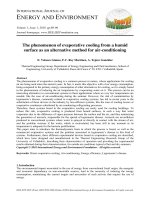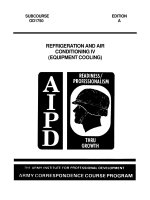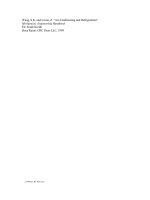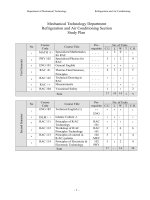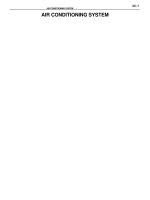- Trang chủ >>
- Khoa Học Tự Nhiên >>
- Vật lý
air conditioning system
Bạn đang xem bản rút gọn của tài liệu. Xem và tải ngay bản đầy đủ của tài liệu tại đây (2.59 MB, 73 trang )
AIR CONDITIONING SYSTEM
–AIR CONDITIONING SYSTEM
AC–1
PRECAUTIONS FOR SERVICING R134a AIR
CONDITIONERS
1. USE OF NEW REFRIGERANT R134a
The very different characteristics of refrigerants
R134a and R12 have determined the design of their
respective air conditioning systems. Under no circum–
stances allow R12 to enter an R134a system, or vice
versa, because serious damage could occur.
GENERAL DESCRIPTION
NEW AIR CONDITIONING SYSTEM WITH
R134a
Refrigerant R12 (CFC12), previously used in automo–
biles air conditioning systems is believed to contribute
towards the depletion the earth’s ozone layer. The
ozone layer help to protect us against the harmful
ultraviolet rays of the sun.
2. USE OF PROPER COMPRESSOR OIL
Compressor oil used in conventional R12 air condi–
tioning systems cannot be used in R 134a air condi–
tioning systems.
Always use genuine Toyota R1 34a air conditioning oil
N D – OIL 8, made expressly for use with R 1 34a.
If even a small amount of the wrong oil is changed, it
will result in clouding of the refrigerant.
A large amount will cause the compressor to seize up.
A newly developed refrigerant, R134 a (HFC 134 a),
does not the destroy the ozone layer.
–AIR CONDITIONING SYSTEM GENERAL DESCRIPTION
AC–2
4. TIGHTEN CONNECTING PARTS SECURELY
Securely tighten the connecting parts to prevent leak–
ing of refrigerant gas.
Apply a few drops of compressor oil to 0–ring
fittings for easy tightening and to prevent leaking
of refrigerant gas.
CAUTION: Apply only ND–OIL 8 compressor oil
Tighten the nuts using 2 wrenches to avoid twist–
ing the tube.
Tighten the 0–ring fittings or the bolted type
fittings to the specified torque.
5. INSERT PLUG IMMEDIATELY IN DISCONNECTED
PARTS
Insert a plug immediately in the disconnected parts to
prevent the ingress of moisture and dust.
6. DO NOT REMOVE PLUG FROM NEW PARTS UNTIL
IMMEDIATELY BEFORE INSTALLATION
3. USE OF PROPER O – RINGS AND SEALS
0–rings and seals used for conventional R12 air
conditioning systams cannot be used for R134a air
conditioning systems.
Always use genuine Toyota R 134a system 0–rings
and seals for R 1 34a air conditioning systems.
7. DISCHARGE GAS IN NEW COMPRESSOR FROM
CHARGING VALVE BEFORE INSTALLING IT
If the gas in the new compressor is not discharged
first, compressor oil will spray out with gas when the
plug is removed.
If O–rings and/or seals for R1 2 air conditioning sys–
tems are used by mistake in the connections of an R
134a air conditioning system, the O–ring and seals
will foam and swell resulting in leakage of refrigerant.
–AIR CONDITIONING SYSTEM GENERAL DESCRIPTION
AC–3
3. USE VACUUM PUMP ADAPTER
By connecting a vacuum pump adapter, the vacuum
pump can be used for both R 134a and R 12 air condi–
tioning systems.
The vacuum pump adaptor has an internal magnetic
valve.
When evacuation is completed and the vacuum pump
switch is turned off, the magnetic valve opens allow–
ing the introduction atmospheric air into the manifold
gauges to prevent the back flow of oil from the
vacuum pump into the gauge hose.
CAUTION:
Be sure to turn off the manifold gauge valve immediately
after evacuating the system. Then you may switch off
the vacuum pump. If this order is reversed, the line will
be temporarily open to atmosphere.
SERVICE TOOLS FOR R134a AIR
CONDITIONER
When servicing R134a air conditioning systems
always use the R134a dedicated manifold gauges, gas
leak detector and vacuum pump adaptor.
1. USE MANIFOLD GAUGES FOR R134a AIR CONDITI–
ONER
Always use R134a dedicated manifold gauges to pre–
vent R1 2 and RI 2 compressor oil contaminating the R
134a system.
2. USE R134a GAS LEAK DETECTOR
Similarly, always use an R 134a dedicated leak detec–
tor. The R1 2 leak detector is not sufficiently sensitive.
–AIR CONDITIONING SYSTEM GENERAL DESCRIPTION
AC–4
3. BE CAREFUL THAT LIQUID REFRIGERANT DOES
NOT GET IN YOUR EYES OR ON YOUR SKIN
If liquid refrigerant gets in your eyes or on your skin:
(a) Wash the area with lots of cool water.
CAUTION: Do not rub your eyes or skin.
(b) Apply clean petroleum jelly to the skin.
(c) GO immediately to a physician or hospital for profes–
sional treatment.
HANDLING PRECAUTIONS FOR
REFRIGERANT CONTAINER
1. NEVER HEAT CONTAINER OR EXPOSE IT TO
NAKED FLAME
2. BE CAREFUL NOT TO DROP CONTAINER AND NOT
TO APPLY PHYSICAL SHOCKS TO IT
HANDLING PRECAUTIONS FOR
REFRIGERANT
1. DO NOT HANDLE REFRIGERANT IN AN ENCLOSED
AREA OR NEAR AN OPEN FLAME
2. ALWAYS WEAR EYE PROTECTION
CHARGING AND LEAK–CHECK METHODS
Evacuate the refrigeration system according to the
following procedures.
Fill refrigerant in gas state until
gauge pressure reads 1 kglcm2
Abnormal indication of
manifold gauges
Check and correct
pipe joints
Refrigerant
Charge
Refrigerant
Charge
Start
Evacuation
Stop
Evacuation
Leave for 5 min.
Gas Leak
Check
Airtight
Check
10 min.
–AIR CONDITIONING SYSTEM GENERAL DESCRIPTION
AC–5
CAUTION:
• Be sure to connect both the high and low pressure
quick–connectors onto the A/C system when eva–
cuating. If only one side is connected, the system
would be open to atmosphere through the other
connector, making it impossible to maintain
vacuum.
• Be sure to turn off the manifold gauge valve imme–
diately after evacuating the system. Then you may
switch off the vacuum pump.
PRECAUTIONS WHEN CHARGING
REFRIGERANT
1. DO NOT OPERATE COMPRESSOR WITHOUT
ENOUGH REFRIGERANT IN REFRIGERANT
SYSTEM
If there is not enough refrigerant in the refrigerant
system oil lubrication will be insufficient and compres–
sor burnout may occur, so take care to avoid this.
2. DO NOT OPEN HIGH PRESSURE MANIFOLD VALVE
WHILST COMPRESSOR IS OPERATING
If the high pressure valve is opened, refrigerant flows
in the reverse direction and could cause the charging
cylinder to rupture, so open and close the low pres–
sure valve only.
3. BE CAREFUL NOT TO OVERCHARGE WITH RE–
FRIGERANT IN SYSTEM
If refrigerant is overcharged, it causes problems such
as insufficient cooling, poor fuel economy, engine
overheating etc.
ELECTRICAL PARTS
Before removing and inspecting the electrical parts,
set the ignition switch to the LOCK position and
disconnect the negative (–) terminal cable from bat–
tery.
CAUTION: Work must be started after 90 seconds from
the time the Ignition switch is turned to the “LOCK”
position and the negative (–) terminal cable is discon–
nected from the battery.
–AIR CONDITIONING SYSTEM GENERAL DESCRIPTION
AC–6
SUPPLEMENTAL RESTRAINT SYSTEM
(SRS)
Failure to carry out service operations in the correct
sequence could cause the supplemental restraint
system to deploy, possibly leading to a serious acci–
dent.
During removal or installation of the parts and the
yellow wire harness and connector for the airbag is
necessary, refer to the precautionary notices in the RS
section before performing the operation.
CAUTION: Work must be started after 90 seconds from
the time the ignition switch is turned to the “LOCK”
position and the negative (–) terminal cable is discon–
nected from the battery.
–AIR CONDITIONING SYSTEM GENERAL DESCRIPTION
AC–7
DESCRIPTION
PARTS LOCATION
–AIR CONDITIONING SYSTEM DESCRIPTION
AC–8
–AIR CONDITIONING SYSTEM DESCRIPTION
AC–9
ELECTRICAL WIRING DIAGRAM
(Lever Type On 5S–FE Engine Model)
–AIR CONDITIONING SYSTEM DESCRIPTION
AC–10
–AIR CONDITIONING SYSTEM DESCRIPTION
AC–11
(Push Button Type On 5S–FE Engine Model)
–AIR CONDITIONING SYSTEM DESCRIPTION
AC–12
–AIR CONDITIONING SYSTEM DESCRIPTION
AC–13
(Lever Type On 1 MZ–FE Engine Model)
–AIR CONDITIONING SYSTEM DESCRIPTION
AC–14
–AIR CONDITIONING SYSTEM DESCRIPTION
AC–15
(Push Button Type On 1 MZ–FE Engine Model)
–AIR CONDITIONING SYSTEM DESCRIPTION
AC–16
–AIR CONDITIONING SYSTEM DESCRIPTION
AC–17
DAMPERS POSITION
–AIR CONDITIONING SYSTEM DESCRIPTION
AC–18
PREPARATION
SST (SPECIAL SERVICE TOOLS)
(07117–58070) T–Joint
(07117–78050) Refrigerant Charging Gauge
(07117–58080) Quick Coupler
(07117–88070) Refrigerant Charging Hose
(07117–58090) Quick Coupler
(07117–88060) Refrigerant Charging Hose
(07117–88080) Refrigerant Charging Nose
(07117–58060) Refrigerant Drain Service Valve
Suction (diam. 13 mm)
Discharge (diam. 16 mm)
Suction (Blue)
Discharge (Red)
Utility (Green)
07116–38360 Gas Leak Detector Assembly
07110–58060 Air Conditioner Service Tool Set
07112–66040 Magnetic Clutch Remover
07112–76060 Magnetic Clutch Stopper
07114–84020 Snap Ring Pliers
–AIR CONDITIONING SYSTEM PREPARATION
AC–19
RECOMMENDED TOOL
09082–00050 TOYOTA Electrical Tester Set
When replacing compressor
When replacing evaporator
When replacing condenser
ND–OIL 8 or equivalent
When replacing receiver
LUBRICANT
10 cc (0.34 fl.oz.)
140 cc (4.9 fl.oz.)
40 cc (1.4 fl.oz.)
40 cc (1.4 f I.oz.)
Compressor oil
Classification
Capacity
Item
–AIR CONDITIONING SYSTEM PREPARATION
AC–20
USE OF MANIFOLD GAUGE SET
MANIFOLD GAUGE SET INSTALLATION
1. CONNECT CHARGING HOSES TO MANIFOLD
GAUGE SET
Tighten the nuts by hand.
CAUTION: Do not connect the wrong hoses.
2. CONNECT QUICK CONNECTORS TO CHARGING
HOSES
Tighten the nuts by hand.
3. CLOSE BOTH HAND VALVES OF MANIFOLD
GAUGE SET
4. REMOVE CAPS FROM SERVICE VALVES ON RE–
FRIGERANT LINE
MANIFOLD GAUGE SET REMOVAL
1. CLOSE BOTH HAND VALVES OF MANIFOLD
GAUGE SET
2. DISCONNECT QUICK CONNECTORS FROM SER–
VICE VALVES ON REFRIGERANT LINE
HINT: Slide the sleeve of the quick connector upward
to unlock the connector and remove it from the ser–
vice valve.
3. INSTALL CAPS TO SERVICE VALVES ON REFRIG–
ERANT LINE
5. CONNECT QUICK CONNECTORS TO SERVICE
VALVES
HINT: Push the quick connector onto the service
valve, then slide the sleeve of the quick connector
downward to lock it.
–AIR CONDITIONING SYSTEM USE OF MANIFOLD GAUGE SET
AC–21
TROUBLESHOOTING
Use the table below to help you find the cause of problem. The numbers indicate the priority of
the likely cause of the problem. Check each rt in order. If necessary, replace these parts.
Inspect Refrigeration
System with Manifold Gauge Set
Cool air comes out only at high
engine speed
No engine idle up when A/C
switch on
Air temp. control not functioning
Cool air comes out intermittently
Inspect Volume of Refrigerant
Revolution Detecting Sensor
Insufficient flow of warm air
Inspect Drive Belt Tension
Insufficient flow of cool air
No air flow mode control
Evaporator Temp. Sensor
No warm air comes out
Magnet Clutch Relay
No cool air comes out
No blower operation
Insufficient cooling
No air inlet control
No blower control
A/C Fan Relays
Pressure Switch
Fuse (A/C)
Fusible Link
Parts
Name
See page
Trouble
AC–60AC–30
AC–24
AC–64
AC–63
AC–62
AC–63
AC–29
–AIR CONDITIONING SYSTEM TROUBLESHOOTING
AC–22
Wiring or Wiring Connection
Expansion Valve (Replace)
A/C Control Assembly
Air out let Servomotor
Condenser Fan Motor
Air Inlet Servomotor
Magnet Clutch
Blower Resistor
A/C Amplifier
Blower Motor
Compressor
Evaporator
Condenser
Receiver
AC–57
AC–58
AC–47
AC–67
AC–49
AC–45
AC–53
AC–56 AC–66
AC–55
AC–36
AC–36
AC–59
–AIR CONDITIONING SYSTEM TROUBLESHOOTING
AC–23
REFRIGERANT SYSTEM INSPECTION WITH MANIFOLD GAUGE SET
This is a method in which the trouble is located by using a manifold gauge set.
(See ”USE OF MANIFOLD GAUGE SET” on page AC–21)
Read the manifold gauge pressure when the following conditions are established:
(a) Temperature at the air inlet with the switch set at RECIRC is 30 – 35 _C (86 – 95 _F)
(b) Engine running at 1,500 rpm
(c) Blower speed control switch set at high
(d) Temperature control set at max. cool
HINT: It should be noted that the gauge indications may vary slightly due to ambient temperature
conditions.
1. NORMALLY FUNCTIONING REFRIGERATION SYSTEM
Gauge reading:
Low pressure side:
0.15 – 0.25 MPa (1.5 – 2.5 kgf/cm’)
High pressure side:
1.37 – 1.57 MPa (14 – 16 kgf/emt)
–AIR CONDITIONING SYSTEM TROUBLESHOOTING
AC–24
(1) Check for gas leakage
with leak detector and
repair if necessary
(2) Charge refrigerant to
proper arhount
(3) If pressure indicated
value is near 0 when
connected to gauge,
create the vacuum af–
ter inspecting and re–
pairing the location of
the leak
• Drier in oversaturated
state
• Moisture in refrigeration
system freezes at expan–
sion valve orifice and
blocks circulation of re–
frigerant
• Moisture entered in re–
frigeration system
freezes at expansion
valve orifice and tempo–
rarily stops cycle, but
normal state is restored
after a time when the ice
melts
(1) Replace receiver/drier
(2) Remove moisture in
cycle through repeat–
edly evacuating air
(3) Charge new refrigerant
to proper amount
• Pressure low on both
low and high pressure
sides
• Bubbles seen in sight
glass continuously
• Insufficient cooling per–
formance
• During operation, prea–
sure on low pressure
side sometimes
becomes a vacuum
and sometimes normal
2. MOISTURE PRESENT IN REFRIGERATION SYSTEM
• Insufficient refrigerant in
system
1
• Refrigerant leaking
Condition: Periodically cools and then fails to cool
• Gas leakage at some
place in refrigeration sys–
tem
3. INSUFFICIENT REFRIGERANT
Symptom seen in
refrigeration system
Condition: Insufficient cooling
Symptom seen in
refrigeration system
Probable cause
Probable cause
Diagnosis
Diagnosis
Remedy
Remedy
–AIR CONDITIONING SYSTEM TROUBLESHOOTING
AC–25
